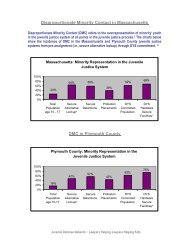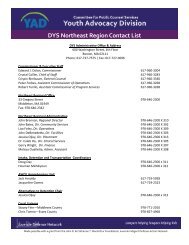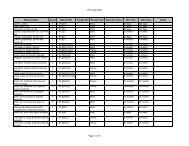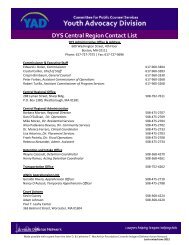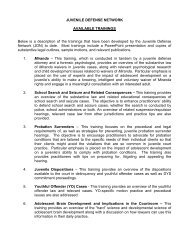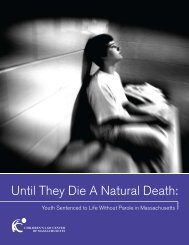States rethink 'adult time for adult crime' - the Youth Advocacy Division
States rethink 'adult time for adult crime' - the Youth Advocacy Division
States rethink 'adult time for adult crime' - the Youth Advocacy Division
Create successful ePaper yourself
Turn your PDF publications into a flip-book with our unique Google optimized e-Paper software.
What Makes Teens Tick; A flood of hormones, sure. But also a host of struct...plain <strong>the</strong> behaviors that make adolescence so exciting--and so exasperating<br />
At McLean Hospital in Belmont, Mass., Harvard neuropsychologist Deborah Yurgelun-<br />
Todd did an elegant series of FMRI experiments in which both kids and <strong>adult</strong>s were<br />
asked to identity <strong>the</strong> emotions displayed in photographs of faces. "In doing <strong>the</strong>se<br />
tasks," she says, "kids and young adolescents rely heavily on <strong>the</strong> amygdala, a<br />
structure in <strong>the</strong> temporal lobes associated with emotional and gut reactions. Adults<br />
rely less on <strong>the</strong> amygdala and more on <strong>the</strong> frontal lobe, a region associated with<br />
planning and judgment." While <strong>adult</strong>s make few errors in assessing <strong>the</strong> photos, kids<br />
under 14 tend to make mistakes. In particular, <strong>the</strong>y identify fearful expressions as<br />
angry, confused or sad. By following <strong>the</strong> same kids year after year, Yurgelun-Todd<br />
has been able to watch <strong>the</strong>ir brain-activity pattern--and <strong>the</strong>ir judgment--mature.<br />
Fledgling physiology, she believes, may explain why adolescents so frequently<br />
misread emotional signals, seeing anger and hostility where none exists. Teenage<br />
ranting ("That teacher hates me!") can be better understood in this light.<br />
At Temple University, Steinberg has been studying ano<strong>the</strong>r kind of judgment: risk<br />
assessment. In an experiment using a driving-simulation game, he studies teens and<br />
<strong>adult</strong>s as <strong>the</strong>y decide whe<strong>the</strong>r to run a yellow light. Both sets of subjects, he found,<br />
make safe choices when playing alone. But in group play, teenagers start to take<br />
more risks in <strong>the</strong> presence of <strong>the</strong>ir friends, while those over age 20 don't show much<br />
change in <strong>the</strong>ir behavior. "With this manipulation," says Steinberg, "we've shown<br />
that age differences in decision making and judgment may appear under conditions<br />
that are emotionally arousing or have high social impact." Most teen crimes, he says,<br />
are committed by kids in packs.<br />
O<strong>the</strong>r researchers are exploring how <strong>the</strong> adolescent propensity <strong>for</strong> uninhibited risk<br />
taking propels teens to experiment with drugs and alcohol. Traditionally,<br />
psychologists have attributed this experimentation to peer pressure, teenagers'<br />
attraction to novelty and <strong>the</strong>ir roaring interest in loosening sexual inhibitions. But<br />
researchers have raised <strong>the</strong> possibility that rapid changes in dopamine-rich areas of<br />
<strong>the</strong> brain may be an additional factor in making teens vulnerable to <strong>the</strong> stimulating<br />
and addictive effects of drugs and alcohol. Dopamine, <strong>the</strong> brain chemical involved in<br />
motivation and in rein<strong>for</strong>cing behavior, is particularly abundant and active in <strong>the</strong><br />
teen years.<br />
Why is it so hard to get a teenager off <strong>the</strong> couch and working on that all important<br />
college essay You might blame it on <strong>the</strong>ir immature nucleus accumbens, a region in<br />
<strong>the</strong> frontal cortex that directs motivation to seek rewards. James Bjork at <strong>the</strong><br />
National Institute on Alcohol Abuse and Alcoholism has been using fMRI to study<br />
motivation in a challenging gambling game. He found that teenagers have less<br />
activity in this region than <strong>adult</strong>s do. "If adolescents have a motivational deficit, it<br />
may mean that <strong>the</strong>y are prone to engaging in behaviors that have ei<strong>the</strong>r a really<br />
high excitement factor or a really low ef<strong>for</strong>t factor, or a combination of both." Sound<br />
familiar Bjork believes his work may hold valuable lessons <strong>for</strong> parents and society.<br />
"When presenting suggestions, anything parents can do to emphasize more<br />
immediate payoffs will be more effective," he says. To persuade a teen to quit<br />
drinking, <strong>for</strong> example, he suggests stressing something immediate and tangible--<strong>the</strong><br />
danger of getting kicked off <strong>the</strong> football team, say--ra<strong>the</strong>r than a future on skid row.<br />
Persuading a teenager to go to bed and get up on a reasonable schedule is ano<strong>the</strong>r<br />
matter entirely. This kind of decision making has less to do with <strong>the</strong> frontal lobe than<br />
with <strong>the</strong> pineal gland at <strong>the</strong> base of <strong>the</strong> brain. As night<strong>time</strong> approaches and daylight<br />
recedes, <strong>the</strong> pineal gland produces melatonin, a chemical that signals <strong>the</strong> body to<br />
begin shutting down <strong>for</strong> sleep. Studies by Mary Carskadon at Brown University have<br />
shown that it takes longer <strong>for</strong> melatonin levels to rise in teenagers than in younger<br />
kids or in <strong>adult</strong>s, regardless of exposure to light or stimulating activities. "The brain's<br />
program <strong>for</strong> starting night<strong>time</strong> is later," she explains.<br />
PRUNING PROBLEMS<br />
The new discoveries about teenage brain development have prompted all sorts of<br />
questions and <strong>the</strong>ories about <strong>the</strong> timing of childhood mental illness and cognitive<br />
file:///L|/JDN/Brain%20Resources/Brain%20Developmen...iling%20Packet/8.%20What%20Makes%20Teens%20Tick.htm (5 of 8)8/16/2006 4:44:18 PM





